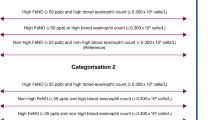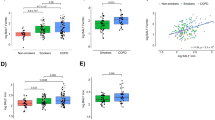Abstract
Serum concentrations of magnesium and manganese may be associated with increased chronic obstructive pulmonary disease exacerbation risk. However, associations with other aspects of asthma-chronic obstructive pulmonary disease overlap, pulmonary function test results and health status, have been studied less extensively. The aim of this study was to investigate the associations between serum concentrations of trace elements and T lymphocyte subsets, FeNO, and COPD-related questionnaire scores in individuals with ACO and the potential impact of these parameters on lung function. All the patients met the diagnostic criteria of ACO and were divided into two groups (group A, mild–moderate; group B, severe–very severe) by their specific characteristics. Pulmonary function testing and serum Mg and serum Mn and FeNO were measured. Four hundred sixty-five patients were screened, and 42 were included. Group A had significantly higher Mg and Fe concentrations than group B. No significant differences were seen in the serum concentration of any other trace element between the two groups. Serum Mg and Mn were correlated with FEV1% predicted (p < 0.01). Group A had a significantly higher FeNO concentration than group B (p = 0.005). The scores on CAT (p = 0.011) and mMRC (p = 0.008) in group A were lower than in group B. The low-FeNO group had a significantly lower concentration of serum Mg than the high-FeNO group (p = 0.03). Pulmonary function declined faster (p < 0.05) in the low-FeNO group than the high-FeNO group. Serum Mg concentration may indicate protective effects against lung function loss in ACO. This implies that FeNO might be a biomarker for identifying individuals with ACO who might benefit from inhaled corticosteroid therapy. Serum Mg and FeNO were associated with ACO severity. However, their role in guiding personalised treatment of individuals with ACO needs to be further investigated.


Similar content being viewed by others
References
Singh D, Agusti A, Anzueto A, Barnes PJ, Bourbeau J, Celli BR, Criner GJ, Frith P, Halpin DMG, Han M, López Varela MV, Martinez F, Montes de Oca M, Papi A, Pavord ID, Roche N, Sin DD, Stockley R, Vestbo J, Wedzicha JA, Vogelmeier C (2019) Global strategy for the diagnosis, management, and prevention of chronic obstructive lung disease: the GOLD science committee report 2019. Eur Respir J 53:1900164. https://doi.org/10.1183/13993003.00164-2019
Global Initiative for Asthma (GINA), Global Initiative for Chronic Obstructive Lung Disease (GOLD) (2017) Diagnosis and initial treatment of asthma, COPD, and asthma–COPD overlap. Available from: https://ginasthma.org/
Barrecheguren M, Pinto L, Mostafavi-Pour-Manshadi SM (2020) Identification and definition of asthma-COPD overlap: the CanCOLD study. Respirology 25:836–849
Song P, Zha M, Xia W, Zhu Y (2020) Asthma-chronic obstructive pulmonary disease overlap in China: prevalence, associated factors and comorbidities in middle-aged and older adults. Curr Med Res Opin:1–9
Arslan M, Soylu M, Kaner G (2016) Başmısırlı, evaluation of malnutrition detected with the nutritional risk screening 2002 (NRS-2002) and the quality of life in hospitalized patients with chronic obstructive pulmonary disease. Hippokratia 20(2):147–152
Ahmadi A, Haghighat N, Hakimrabet M, Tolide-ie H (2012) Nutritional evaluation in chronic obstructive pulmonary disease patients. Pak J Biol Sci 15(10):501–505
Zhai T, Li S, Hu W, Leng S (2018) Potential micronutrients and phytochemicals against the pathogenesis of chronic obstructive pulmonary disease and lung cancer. Nutrients 10(7)
Leng S, Picchi MA, Tesfaigzi Y, Belinsky SA (2017) Dietary nutrients associated with preservation of lung function in Hispanic and non-Hispanic white smokers from New Mexico. Int J Chron Obstruct Pulmon Dis 12:3171–3181
Hashim Ali Hussein S, Nielsen LP, Konow Bøgebjerg Dolberg M, Dahl R (2015) Associated with better QoL in COPD: A cross-sectional study. Respir Med 109(6):727–733
Topf JM, Murray PT (2003) Hypomagnesemia and hypermagnesemia. Rev Endocr Metab Disord 4(2):195
Rude RK, Oldham SB, Singer FR (1976) Functional hypoparathyroidism and parathyroid hormone end-organ resistance in human magnesium deficiency. Clin Endocrinol 5(3):209
Huang CL, Kuo E (2007) Mechanism of hypokalemia in magnesium deficiency. J Am Soc Nephrol 18(10):2649
Dominguez LJ, Barbagallo M, Lauretani F, Bandinelli S, Bos A, Corsi AM et al (2006) Magnesium and muscle performance in older persons: the InCHIANTI study. Am J Clin Nutr 84(2):419
Brilla LR, Haley TF (1992) Effect of magnesium supplementation on strength training in humans. J Am Coll Nutr 11(3):326
Postnikova LB, Alekseeva OP, Kubysheva NI, Gorshkova TN, Ishanova OS (2004) Significance of biochemical parameters of saliva in the diagnosis of chronic obstructive pulmonary disease at exacerbation. Klin Lab Diagn 10:16
Ruljancic N, Popovic-Grle S, Rumenjak V, Sokolic B, Malic A, Mihanovic M et al (2007) COPD: magnesium in the plasma and polymorphonuclear cells of patients during a stable phase. COPD 4(1):41–47
Gumus A, Haziroglu M, Gunes Y (2014) Association of serum magnesium levels with frequency of acute exacerbations in chronic obstructive pulmonary disease: a prospective study. Pulm Med 2014:329476
McKeever TM, Lewis SA, Smit HA, Burney P, Cassano PA, Britton J (2008) A multivariate analysis of serum nutrient concentrations and lung function. Respir Res 9:67
Soldin OP, Aschner M (2007) Effects of manganese on thyroid hormone homeostasis. Neurotoxicology 28(5):951–956. https://doi.org/10.1016/j.neuro.2007.05.003
Jain RB, Choi YS (2015) Normal reference ranges for and variability in the levels of blood manganese and selenium by gender, age, and race/ethnicity for the general U.S. population. J Trace Elem Med Biol 30:142–152. https://doi.org/10.1016/j.jtemb.2014.12.004
Kim YJ, Kim YK, Kho HS (2010) Effects of smoking on trace metal levels in saliva. Oral Dis 16:823–830. https://doi.org/10.1111/j.1601-0825.2010.01698.x
Ates Alkan F, Karis D, Cakmak G, Ercan AM (2019) Analysis of the relationship between hemorheologic parameters, aluminum, manganese, and selenium in smokers. Biol Trace Elem Res 187(1):22–31
American Thoracic Society. European Respiratory Society (2005) ATS/ERS recommendations for standardized procedures for the online and offline measurement of exhaled lower respiratory nitric oxide and nasal nitric oxide, 2005. Am J Respir Crit Care Med 171(8):912–930
Liu X, Zhang H, Wang Y, Huang K (2020) Fractional exhaled nitric oxide is sssociated with the severity of stable COPD. COPD:1–7
Taylor DR, Pijnenburg MW, Smith AD et al (2006) Exhaled nitricoxide measurements: clinical application and interpretation [J]. Thorax 61(9):817–827
Zhan W, Tang J, Chen X, Lai K (2019) Duration of treatment with inhaled corticosteroids in nonasthmatic eosinophilic bronchitis: a randomized open-label trial. Ther Adv Respir Dis 13:1753466619891520
Jones P, Harding G, Berry P et al (2009) Development and first validation of the COPD assessment test. Eur Respir J 34:648–654
Bestall J, Paul E, Garrod R, Garnham R, Jones P, Wedzicha J (1999) Usefulness of the Medical Research Council (MRC) dyspnoea scale as a measure of disability in patients with chronic obstructive pulmonary disease. Thorax 54(7):581–586
Yılmaz D, Çapan N, Canbakan S, Besler HT (2015) Severe COPD in relation to fat-free mass index: a cross-sectional study. Nutr J 14:35
Ahmadi A, Haghighat N, Hakimrabet M, Tolide-ie H (2012) Nutritional evaluation in chronic obstructive pulmonary disease patients. Pak J Biol Sci 15(10):501–505
Hashim Ali Hussein S, Nielsen LP, Konow Bøgebjerg Dolberg M, Dahl R (2015) Serum magnesium and not vitamin D is associated with better QoL in COPD: a cross-sectional study. Respir Med 109(6):727–733
Janssen R, Fischer I, Wouters EF (2018) Inhalation therapy for repairing damaged elastin fibers and decelerating elastinolysis in chronic obstructive pulmonary disease. Expert Rev Respir Med 12(5):349–360
Janssen R (2017) Magnesium to counteract elastin degradation and vascular calcification in chronic obstructive pulmonary disease. Med Hypotheses 107:74–77
Mukerji S, Shahpuri B, Clayton-Smith B, Marsh E (2015) Intravenous magnesium sulphate as an adjuvant therapy in acute exacerbations of chronic obstructive pulmonary disease: a single centre, randomised, double-blinded, parallel group, placebo-controlled trial: a pilot study. N Z Med J 128(1425):34–42
Amaral AF, Gallo L, Vannucchi H, Martinez JA (2012) The effect of acute magnesium loading on the maximal exercise performance of stable chronic obstructive pulmonary disease patients. Clinics (Sao Paulo) 67(6):615–622
El-Attar M, Said M, El-Assal G, Ashour L (2009) Serum trace element levels in COPD patient: the relation between trace element supplementation and period of mechanical ventilation in a randomized controlled trial. Respirology 14(8):1180–1187
Högman M, Thornadtsson A et al (2019) Different relationships between FENO and COPD characteristics in smokers and ex-smokers. COPD 16(3-4):227–233
Fabbri LM, Romagnoli M, Corbetta L, Casoni G, Busljetic K, Turato G, Ligabue G, Ciaccia A, Saetta M, Papi A (2003) Differences in airway inflammation in patients with fixed airflow obstruction due to asthma or chronic obstructive pulmonary disease. Am J Respir Crit Care Med 167:418–424
Papi A, Romagnoli M, Baraldo S et al (2000) Partial reversibility of airflow limitation and increased exhaled NO and sputum eosinophilia in chronic obstructive pulmonary disease. Am J Respir Crit Care Med 162:1773–1777
Author information
Authors and Affiliations
Corresponding author
Ethics declarations
Conflict of Interests
The authors declare that they have no conflict of interest.
Additional information
Publisher’s Note
Springer Nature remains neutral with regard to jurisdictional claims in published maps and institutional affiliations.
Rights and permissions
About this article
Cite this article
Ye, M., Li, Q., Xiao, L. et al. Serum Magnesium and Fractional Exhaled Nitric Oxide in Relation to the Severity in Asthma-Chronic Obstructive Pulmonary Disease Overlap. Biol Trace Elem Res 199, 1771–1777 (2021). https://doi.org/10.1007/s12011-020-02314-5
Received:
Accepted:
Published:
Issue Date:
DOI: https://doi.org/10.1007/s12011-020-02314-5




